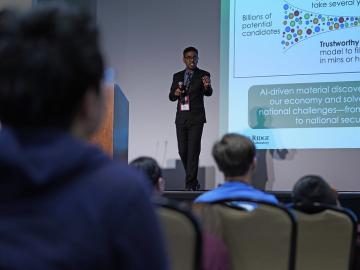
Filter News
Area of Research
News Type
News Topics
- (-) Artificial Intelligence (48)
- (-) Composites (8)
- (-) Environment (104)
- (-) Frontier (24)
- (-) Grid (25)
- (-) Quantum Computing (21)
- (-) Summit (30)
- 3-D Printing/Advanced Manufacturing (41)
- Advanced Reactors (8)
- Big Data (26)
- Bioenergy (51)
- Biology (60)
- Biomedical (29)
- Biotechnology (11)
- Buildings (19)
- Chemical Sciences (25)
- Clean Water (14)
- Climate Change (50)
- Computer Science (86)
- Coronavirus (17)
- Critical Materials (3)
- Cybersecurity (14)
- Decarbonization (46)
- Education (1)
- Emergency (2)
- Energy Storage (29)
- Exascale Computing (26)
- Fossil Energy (4)
- Fusion (31)
- High-Performance Computing (44)
- Hydropower (5)
- Isotopes (27)
- ITER (2)
- Machine Learning (22)
- Materials (43)
- Materials Science (45)
- Mathematics (7)
- Mercury (7)
- Microelectronics (2)
- Microscopy (20)
- Molten Salt (1)
- Nanotechnology (16)
- National Security (39)
- Net Zero (8)
- Neutron Science (47)
- Nuclear Energy (55)
- Partnerships (18)
- Physics (29)
- Polymers (8)
- Quantum Science (30)
- Renewable Energy (1)
- Security (11)
- Simulation (32)
- Software (1)
- Space Exploration (12)
- Statistics (1)
- Sustainable Energy (47)
- Transformational Challenge Reactor (3)
- Transportation (27)
Media Contacts

Two ORNL teams recently completed Cohort 18 of Energy I-Corps, an immersive two-month training program where the scientists define their technology’s value propositions, conduct stakeholder discovery interviews and develop viable market pathways.

Power companies and electric grid developers turn to simulation tools as they attempt to understand how modern equipment will be affected by rapidly unfolding events in a complex grid.

Researchers at the Department of Energy’s Oak Ridge National Laboratory and partner institutions have launched a project to develop an innovative suite of tools that will employ machine learning algorithms for more effective cybersecurity analysis of the U.S. power grid.

Brittany Rodriguez never imagined she would pursue a science career at a Department of Energy national laboratory. However, after some encouraging words from her mother, input from key mentors at the University of Texas Rio Grande Valley, or UTRGV, and a lot of hard work, Rodriguez landed at DOE’s Manufacturing Demonstration Facility, or MDF, at Oak Ridge National Laboratory.

Researchers conduct largest, most accurate molecular dynamics simulations to date of two million correlated electrons using Frontier, the world’s fastest supercomputer. The simulation, which exceed an exaflop using full double precision, is 1,000 times greater in size and speed than any quantum chemistry simulation of it's kind.

In the wet, muddy places where America’s rivers and lands meet the sea, scientists from the Department of Energy’s Oak Ridge National Laboratory are unearthing clues to better understand how these vital landscapes are evolving under climate change.

Researchers used quantum simulations to obtain new insights into the nature of neutrinos — the mysterious subatomic particles that abound throughout the universe — and their role in the deaths of massive stars.
Close on the heels of its fourth summer school, the Quantum Science Center, or QSC, hosted its second in-person all-hands meeting in early May. More than 150 scientists, engineers and support staff traveled from 17 institutions to review the QSC’s progress, examine existing priorities and brainstorm new short- and long-term research endeavors.

Researchers at ORNL and the University of Maine have designed and 3D-printed a single-piece, recyclable natural-material floor panel tested to be strong enough to replace construction materials like steel.

Prasanna Balaprakash, a national leader in artificial intelligence, or AI, spoke to some of the highest achieving students in the country at the National Science Bowl in Washington D.C.


